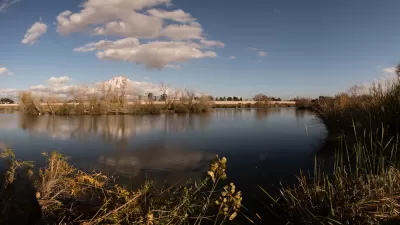In this travelogue, Dwell tours the often-overlooked infrastructure that keeps the metropolis of Los Angeles running.
"Los Angeles is a polarizing city. To some it is a paradise of beautiful beaches, buxom bodies, Beverly Hills, and the world's most pimped-out cars-–a place where you, too, could be discovered, your name in lights, your star forever embedded in the Walk of Fame. To others, it is a glimpse of the apocalypse, one of the forecourts of hell, with its race riots, air pollution, earthquakes, wildfires, and overwhelming extremes of stupidity. Los Angeles is the kind of place some people refuse even to visit."
"Let's put that argument aside and look instead at L.A.'s edges-–not its countercultural hot spots, but the post-industrial voids and internal peripheries that let the city function. For instance, where does L.A. get its water? What about electricity? What about all the sand, gravel, and concrete that went into those thous-ands of freeways, parking lots, and roads? How does such a chaotic and sprawling city actually work? And where does all its trash go?"
"'In order to understand the bigger picture of Los Angeles,' explains Coolidge, 'you have to understand how the city flows in and out of its regional landscape. These are the places that run the city; they're the places that make L.A. what it is. They're places we've constructed so that other, perhaps more minor, activities can occur here. Once you understand how they operate-–how they form a system, how they consort and are connected-–these places do have a beauty to them.'"
FULL STORY: Los Angeles

Maui's Vacation Rental Debate Turns Ugly
Verbal attacks, misinformation campaigns and fistfights plague a high-stakes debate to convert thousands of vacation rentals into long-term housing.

Planetizen Federal Action Tracker
A weekly monitor of how Trump’s orders and actions are impacting planners and planning in America.

In Urban Planning, AI Prompting Could be the New Design Thinking
Creativity has long been key to great urban design. What if we see AI as our new creative partner?

Portland Raises Parking Fees to Pay for Street Maintenance
The city is struggling to bridge a massive budget gap at the Bureau of Transportation, which largely depleted its reserves during the Civd-19 pandemic.

Spokane Mayor Introduces Housing Reforms Package
Mayor Lisa Brown’s proposals include deferring or waiving some development fees to encourage more affordable housing development.

Houston Mayor Kills Another Bike Lane
The mayor rejected a proposed bike lane in the Montrose district in keeping with his pledge to maintain car lanes.
Urban Design for Planners 1: Software Tools
This six-course series explores essential urban design concepts using open source software and equips planners with the tools they need to participate fully in the urban design process.
Planning for Universal Design
Learn the tools for implementing Universal Design in planning regulations.
Gallatin County Department of Planning & Community Development
Heyer Gruel & Associates PA
JM Goldson LLC
City of Camden Redevelopment Agency
City of Astoria
Transportation Research & Education Center (TREC) at Portland State University
Jefferson Parish Government
Camden Redevelopment Agency
City of Claremont





























